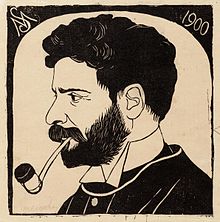Samuel Jessurun de Mesquita
| Samuel Jessurun de Mesquita | |
|---|---|

Self-portrait, 1900
|
|
| Born |
6 June 1868 Amsterdam, Netherlands |
| Died |
c. 11 February 1944 (aged 75) Auschwitz, Nazi Germany |
Samuel Jessurun de Mesquita (6 June 1868 – c. 11 February 1944) was a Dutch graphic artist active in the years before the Second World War. His pupils included graphic artist M. C. Escher (1898–1972). After the war, de Mesquita was largely forgotten.
Samuel Jessurun de Mesquita was born on 6 June 1868 into a Jewish family living in Amsterdam. Though a member of a tightly knit Sephardic community, a minority among Dutch Jews, de Mesquita, like most of his contemporaries, was not religiously observant. His father, a secondary school teacher of Hebrew and German, died when Sam or Sampie, as he was called, was five.
At the age of fourteen, the young de Mesquita applied to the Rijksakademie in pursuit of his artistic interests, only to be rejected. Deeply disappointed, he apprenticed himself to an acting city architect, for whom he worked for two years before entering a technical school with the intention of becoming an architect himself. He soon turned, however, to the pedagogy and, in 1889, received a teacher's certificate, which would later enable him to support his family.
Over the next years, de Mesquita principally devoted himself to art, experimenting with various techniques and mediums. Though known primarily for his wood engravings, he also produced etchings, lithographs, watercolors and drawings; his applied art consisted mostly of material designs. There are birds, exotic animals, plants and flowers, and fantastical representations, both humorous and grim. Among de Mesquita's most beautiful works are his portraits, particularly his self-portraits.
With Nazi Germany's invasion of the Netherlands in May 1940, de Mesquita, already in poor health, was forced to lead a secluded life, limiting his work largely to sketches.
1925
1927
1929
1931
...
Wikipedia
